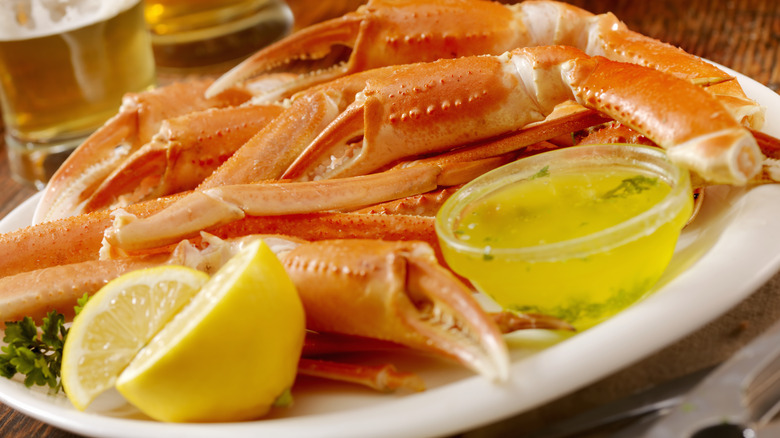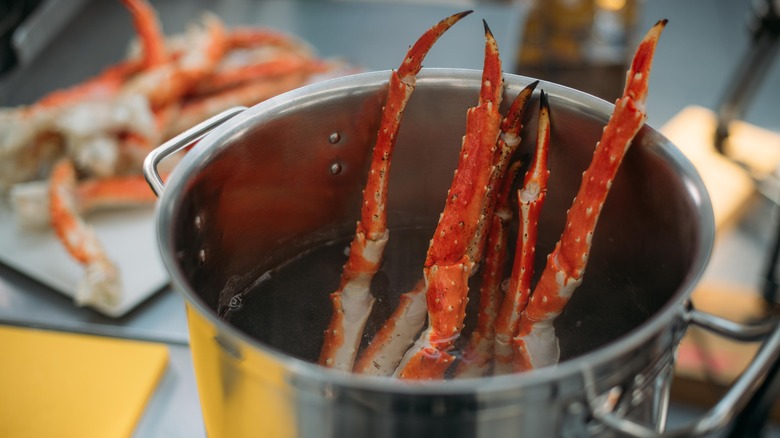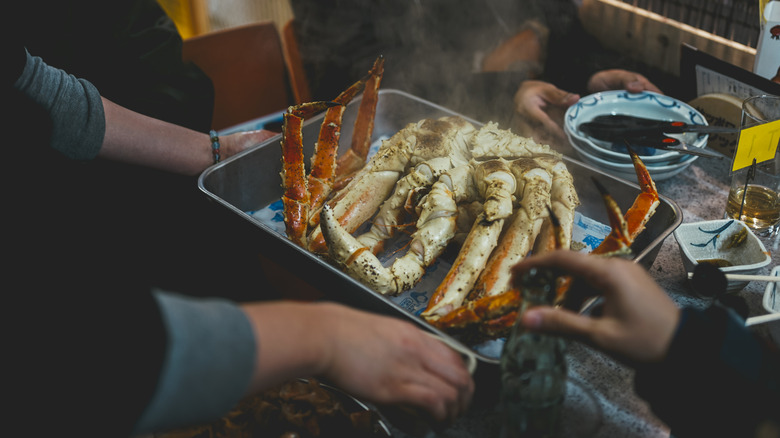The Best Way To Reheat Crab Legs So They Taste Fresh
The sun sets on a hot summer day in Crisfield, Maryland — the crab capital of the world. You're out to dinner at a seafood restaurant, and you order a steaming plate of real, mouthwatering crab legs. None of that imitation crab stuff. The salty smell of the unique Maryland crab fills your nostrils as the server sets down the plate. With your tools in hand, you accept the inevitable mess of cracked shells and buttery fingers, pulling out satisfying chunks of meat until your stomach hits capacity. Uh oh! There's a problem: You just can't finish all of the crab legs in one sitting. Looks like you've got leftovers.
When you're ready to warm up your midnight snack, how should you do it? First things first: Step away from the microwave. Not only does the microwave dehydrate your food, but heating seafood in the nuker will totally stink up your kitchen! Plus, you've got way better options. Instead, we recommend boiling your crab legs for your second round of seafood delight. Boiling is the preferred method for reheating because it is the quickest and easiest way to retain the taste and moisture of the meat.
Tips for boiling your leftover crab
Now, let's get into the nitty-gritty. To boil your crab legs for reheating, you'll need three to five minutes of boiling time, depending on whether you are heating leftover crab legs from the refrigerator or the freezer. No need to remove the meat from the shells prior to boiling; the legs should still be encased during the reheating process. You will also need a pot big enough to fully submerge every claw. Bend those legs if you have to! Getting the crab legs completely under the water ensures that they heat evenly while preventing the meat inside the shell from drying out. Crab shells are actually porous despite their rigid structure, meaning water can penetrate through to the meat.
With that being said, feel free to sprinkle in a pinch of salt with your water to maintain peak ocean flavor in your leftovers. Though it is not required, it is encouraged, as salt tends to bring out umami flavors. Get creative by adding herbs like dill or squeezing in some lemon juice for added flavor. Alternatively, a few shakes of Old Bay is an absolute classic. If you're feeling boozy, empty a bottle of beer into the water! A common misconception about boiling your crab legs is that some of the delicious meaty flavor can be sapped in boiling water, but that doesn't have to be the case. The best part? One big pot of boiling water means fewer dishes to wash during cleanup!
Other ways to reheat your leftover crab
You might also consider steaming your leftover legs. Those who prefer steamed crab may enjoy the natural savory flavor of the crustacean over experimenting with incorporating seasoned stock into the meat. A drawback, however, is the extra chore of washing the different dishes steaming requires.
Steaming will also require a big enough pot to fit your crab legs, accompanied by a tray to separate the water from the crab, and a lid to tightly seal in the steam. With one to two inches of water at the bottom of your pot, turn on the stove until you see water begin to evaporate. Then pop on the lid and let the steam work its magic for roughly five minutes.
If you can't find a pot big enough to accommodate the size of your crab legs, then hopefully, you can find a sheet pan instead. An oven will also work just fine for reheating your leftovers — and before you worry about drying out the meat, there's a fancy trick you can use to seal in the moisture: Wrap all of your crab legs in aluminum foil. Once your oven has preheated to 350 degrees Fahrenheit, bake your crab legs for about 10 to 12 minutes. No matter how you choose to reheat your crabby snack, enjoy!



